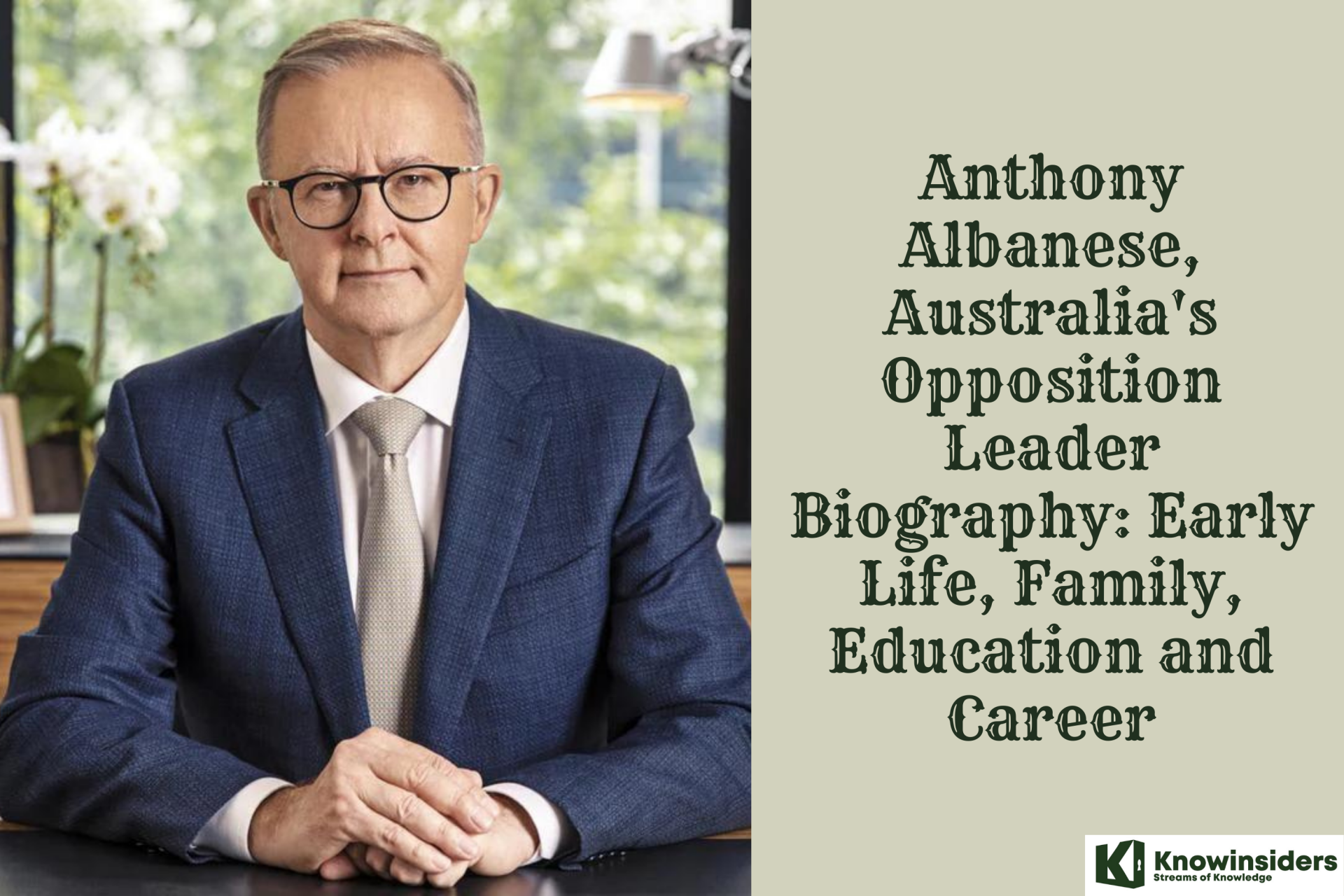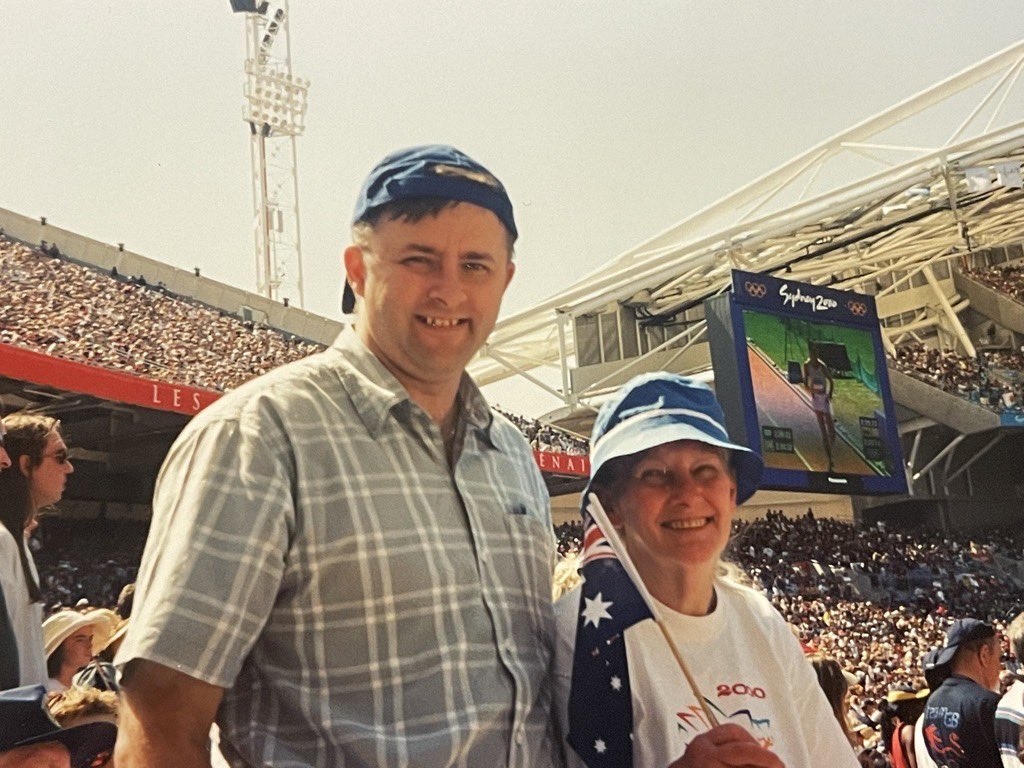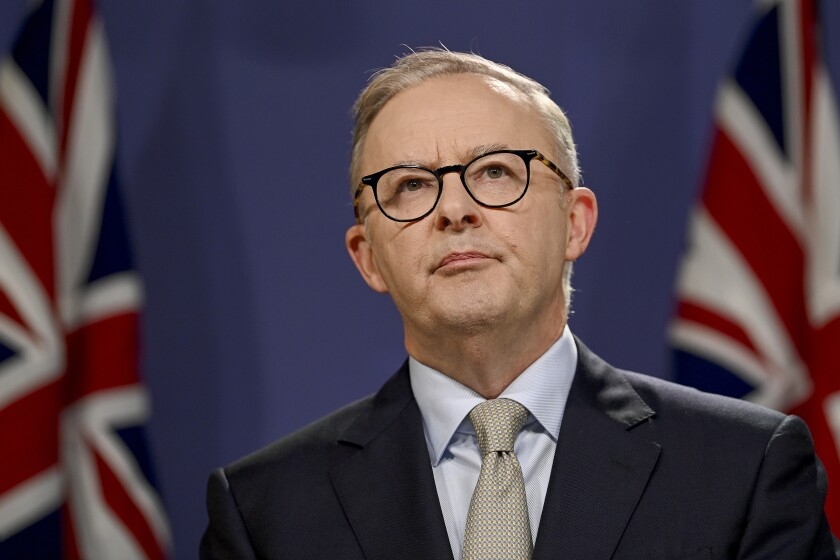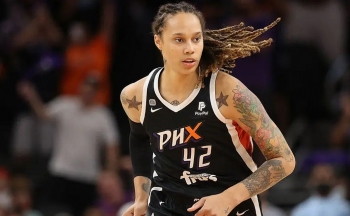Who is Anthony Albanese - Australia's Prime Minister: Biography, Early Life, Family, Education and Career
 |
| Anthony Albanese, Australia's New Prime Minister Biography: Early Life, Family, Education and Career |
Anthony Albanese, the only child of a single mother who was raised in a working-class neighbourhood of Sydney, has led his Labor Party to victory in the national election in Australia, ending nine years of conservative rule.
Who is Anthony Albanese - Australia's Prime Minister
Anthony Albanese is an Australian politician who is currently serving as the Leader of the Opposition and leader of the Australian Labor Party since 2019. He has also been a member of parliament for the division of Grayndler since 1996.
Since being picked as Opposition Leader in 2019, Anthony Albanese has run a small target campaign. Through natural disasters and the pandemic, Mr. Albanese laid low and waited for the government to make missteps.
Now after 26 years in parliament and three years as leader of the opposition, the Coalition is presenting Mr Albanese as an unknown risk.
But there's still a lot that is unknown about Mr. Anthony. Here's a look at the upbringings of Anthony Albanese.
Anthony Albanese: Bring Australians together!Anthony Albanese is set to become Australia's 31st prime minister after Scott Morrison conceded defeat at the federal election. Anthony Albanese has led his Labor Party to victory in the national election in Australia, ending nine years of conservative rule. The opposition Labor party with 72 seats is yet to gain a parliamentary majority in the 151-member parliament, as the counting of votes is still under way. Due to the pandemic, around half of Australia’s 17 million electors have voted early or applied for postal votes, which will likely slow the count. Voting is compulsory for adult citizens and 92% of registered voters cast ballots in the last election. In his first comments after the election win, Albanese said he wanted to bring Australians together. |
Anthony Albanese Early Life and Education
Anthony Albanese is 59 years old; born on March 2, 1963. Anthony grew up with his mum, Maryanne, in a council house. They loved their community, their church, the South Sydney Rabbitohs, and Saturday afternoons on the hill at Redfern Oval. They didn’t have a lot, but they had each other.
Those early years rewarded Anthony with an enduring set of values. His experiences taught him the meaning of hard work, the value of a dollar, and the importance of standing up for what you believe in. Along the way, he learned firsthand that we are all better off when we work together.
As he watched his mum juggling the challenges of life on a disability pension, Anthony came to understand the power of a parent’s love in the face of hardship. He knows how hard mums and dads work to give their children a better life.
This knowledge still drives him today, as a leader – and as a father. His son Nathan is 21. Building a stronger Australia to hand to Nathan’s generation is never far from his mind.
Albanese was educated at St Joseph’s Primary School in Camperdown and St Mary’s Cathedral College in Sydney. His mother Maryanne raised him by herself in public housing, and Albanese would later say that she had raised him with “three great faiths: the Catholic Church, the South Sydney Football Club and Labor”, adding that he had always remained faithful to the latter two.
After finishing school, he worked for the Commonwealth Bank for two years before studying economics at the University of Sydney. There he became involved in student politics and was elected to the Students’ Representative Council. It was also there where he started his rise as a key player in the left faction of the Labor Party. During his time in student politics, Albanese led a group within Young Labor that was aligned with the left faction’s Hard Left, which maintained “links with broader left-wing groups, such as the Communist Party of Australia, People for Nuclear Disarmament and the African National Congress”.
Anthony Albanese Personal Life, Relationships, and Dating
 |
| Photo: Twitter |
Albanese was married to Carmel Tebbutt, former Deputy Premier of New South Wales and former member for the state electoral district of Marrickville, which until its abolition in 2015 overlapped with Grayndler in Sydney’s Inner West. They have one son. Albanese and Tebbutt separated in 2019.
Albanese describes himself as “half-Italian and half-Irish” and a “non-practicising Catholic”. He is also a music fan who reportedly once went to a Pogues gig in a Pixies shirt and intervened as Transport Minister to save a Dolly Parton tour from bureaucratic red tape. In 2013, he co-hosted a pre-election special of music program Rage and his song selection included the Pixies and Pogues alongside the Smiths, the Triffids, PJ Harvey, Hunters & Collectors and Joy Division.
As a lifelong supporter of the South Sydney Rabbitohs, he was a board member of the club from 1999 to 2002 and influential in the fight to have the club readmitted to the National Rugby League competition. During October 2009, The Sydney Morning Herald reported that Albanese had opposed an attempt to appoint the former Liberal Prime Minister John Howard to a senior position in the NRL. Albanese admitted he had phoned the NRL chief executive, David Gallop, as well as other league officials, to advise them against the idea. He then implored officials at Souths to help stop the suggestion from gaining momentum. In 2013, he was made a life member of the club.
Anthony Albanese's Career
Pre-parliamentary career
After completing his economics degree, Albanese took on a role as a research officer to the then-Minister for Local Government and Administrative Services, Tom Uren, who would become a mentor to him. In 1989, the position of Assistant General Secretary of the New South Wales branch of the Labor Party became vacant when John Faulkner was elected to the Senate. The election to replace him was closely disputed between the Labor Left’s Hard Left and Soft Left groupings, with Albanese being elected with the backing of the Hard Left, taking on that role for the next six years. In 1995, he left the position to work as a senior adviser to New South Wales Premier Bob Carr.
Political career
When Jeannette McHugh announced she would not recontest her seat of Grayndler at the 1996 election, Albanese won preselection for the seat. The campaign was a difficult one, with aircraft noise a big political issue following the opening of the third runway at Sydney Airport, and the newly established No Aircraft Noise party (NAN) having polled strongly in the local area at the 1995 New South Wales election. Veteran political pundit Malcolm Mackerras predicted NAN would win the seat. However, NAN’s candidate finished third, with less than 14% of the vote. Despite suffering a six-point swing against Labor, Albanese was elected with a comfortable 16-point margin.
In his maiden speech to the House of Representatives, he spoke about the building of a third runway at Sydney Airport, aircraft noise and the need to build a second airport to service Sydney, as well as his support for funding public infrastructure in general, multiculturalism, native title, the social wage and childcare. He concluded by saying, “For myself, I will be satisfied if I can be remembered as someone who will stand up for the interests of my electorate, for working-class people, for the labour movement, and for our progressive advancement as a nation into the next century.”
In his first year in Parliament, he continued this theme, speaking in favour of the Northern Territory’s euthanasia legislation, the rights of the Indigenous community in the Hindmarsh Island bridge controversy, and entitlement to superannuation for same-sex couples.
This latter issue became a cause to which he was particularly dedicated. In 1998 he unsuccessfully moved a private member’s bill that would have given same-sex couples the same rights to superannuation as de facto heterosexual couples. Over the next nine years, he tried three more times without success, until the election of the Rudd Government in 2007 saw the legislation passed. Albanese subsequently turned his attention to campaigning for same-sex marriage.
Appointment to Shadow Cabinet
In 1998, Albanese was appointed a Parliamentary Secretary, a position that assists ministers and shadow ministers and is often a stepping stone to a full ministerial position.
In 2001 he was promoted to the opposition Shadow Cabinet, taking the portfolio of Ageing and Seniors. A 2002 reshuffle saw him become Shadow Minister for Employment Services and Training, and in 2004 he became Shadow Minister for Environment and Heritage. It was during this latter role that then-Prime Minister John Howard and Science Minister Brendan Nelson started raising the idea of nuclear power for Australia.
Albanese campaigned strongly against them, as well as elements within his own party, arguing, “Nuclear energy doesn’t add up economically, environmentally or socially, and after more than 50 years of debate, we still do not have an answer to nuclear proliferation or nuclear waste.”
In 2005, Anthony Albanese was given the additional role of Shadow Minister for Water alongside his existing responsibilities and was also appointed Deputy Manager of Opposition Business in the House. In December 2006, when Kevin Rudd first became Leader of the Labor Party, Albanese took over from Julia Gillard as Manager of Opposition Business in the House, a senior tactical role on the floor of the parliament, and was appointed Shadow Minister for Water and Infrastructure.
Cabinet Minister
 |
| Photo: sandiegouniontribune |
Following Labor’s victory at the 2007 election, Albanese’s rise in standing within the party as evidenced by his appointment as Minister for Infrastructure and Transport, Minister for Regional Development and Local Government and Leader of the House of Representatives in the Rudd Ministry. Rudd was sworn in alongside his colleagues on 3 December 2007.
The Labor Party had gone to the election criticising the previous government for ignoring “long-term nation-building in favour of short-term political spending”. One of Albanese’s first moves as Minister for Infrastructure and Transport was the establishment of an independent statutory body, Infrastructure Australia, to advise the Government on infrastructure priorities. Armed with advice from this independent body and his own persuasive skills in the Cabinet, he was able to argue for a doubling of the roads budget and a tenfold increase in rail investment.
The establishment of Infrastructure Australia was regarded by many as a success; projects delivered through the Infrastructure Australia process included Melbourne’s Regional Rail Link, the Hunter Expressway, the Ipswich Motorway, the Gold Coast light rail system G: link, the Redcliffe Peninsula railway line, the extension of the Noarlunga Centre railway line to Seaford, South Australia and various projects along the Pacific Highway in NSW and Bruce Highway in Queensland.
Gillard Government
After Julia Gillard replaced Rudd as Prime Minister in June 2010 owing to a leadership spill, she retained Albanese in his roles. Following the 2010 election which resulted in a hung parliament, Albanese was a key player in negotiating the support of independent members Tony Windsor and Rob Oakeshott through his role of Leader of the House. Albanese was also responsible for managing legislation through the House in the first hung parliament since the 1940s.
In 2011, Albanese introduced two more major policy reforms. The first on urban planning drew on the work of Danish designer Jan Gehl and set out plans for urban design with better transport links and safety. The second, on shipping, was notable for gaining the approval of both the conservative Australian Shipowners Associations and the radical Maritime Union of Australia.
However, Anthony Albanese also attracted controversy when a convoy of trucks from North Queensland dubbed the “convoy of no confidence” descended on Canberra’s Parliament House to protest against rising fuel costs and carbon pricing. During question time, Albanese labelled the protesters outside as “the convoy of no consequence”. This caused outrage among supporters of the protest and a week later a public rally in support of the truckies was held outside Albanese’s electorate office in Marrickville.
Following a series of poor polls, leadership instability descended again on the Labor Government. Former Prime Minister Kevin Rudd resigned as Minister for Foreign Affairs in February 2012 to challenge Julia Gillard. Shortly before the ballot, Albanese came out in support of Rudd, stating that he had always been unhappy with the manner of Rudd’s removal. He tearfully explained how he had offered his resignation as Leader of the House to the Prime Minister, but that she had refused to accept it, and called on Labor to cease leadership divisions and unify. In response to a question on his personal feelings around the leadership spill, he stated “I like fighting Tories. That’s what I do.”
Deputy Prime Minister of Australia
Albanese was sworn in as Deputy Prime Minister by Governor-General Quentin Bryce. In June 2013, Rudd defeated Gillard in a final leadership election. That same ballot saw Albanese elected by the caucus as Deputy Leader of the Labor Party, and the following day Albanese was sworn in as Deputy Prime Minister. He held this role until Labor’s defeat at the 2013 election and was replaced by Warren Truss on 18 September.
Return to Opposition
Following the defeat of Labor at the 2013 election, Albanese announced his candidacy to be Leader of the Labor Party, standing against Bill Shorten. Shorten was announced as the winner after a month-long contest that was the first to involve a combined vote of MPs and rank-and-file members. Although Albanese won comfortably among party members, Shorten held a greater lead among MPs, and was duly elected.
In October 2013, shortly after the leadership election, Shorten appointed Albanese Shadow Minister for Infrastructure and Transport and Shadow Minister for Tourism; he would hold these roles throughout Shorten’s time as leader. In September 2014, Albanese was given additional responsibility as the Shadow Minister for Cities.
Leader of the Opposition
Bill Shorten announced his resignation as Leader of the Labor Party on 18 May 2019, following Labor’s unexpected defeat in the 2019 election. The day after, Albanese announced his candidacy in the subsequent leadership election. On 21 May, Chris Bowen announced he would also contest the ballot; however, the next day, he announced his withdrawal, citing his lack of support among the party membership. With no other candidate stepping forward, Albanese took the leadership unopposed on 30 May, with Richard Marles as his deputy. Aged 56 when he took office, he is the oldest first-time Opposition Leader in 59 years, since Arthur Calwell (aged 63) took office in 1960.
Anthony Albanese's Political Views
 |
| Albanese rose through the Labor ranks, finally taking over the opposition leadership after the party's crushing loss in 2019 |
Anthony Albanese has described his political views as progressive, and he is aligned with the Labor Left. He is in favour of a republican Australia and supports replacing the current constitutional monarchy.
Albanese is in favour of legalising voluntary euthanasia. He is a supporter and advocate for LGBT rights, and often participates in the annual Sydney Gay and Lesbian Mardi Gras. Albanese opposed holding a plebiscite for same-sex marriage, stating that “we shouldn’t be having a public vote where we get to judge other families”. In 2017, Albanese voted “Yes” to the Marriage Amendment (Definition and Religious Freedoms) Act 2017, which posed the question of if same-sex couples should be allowed to marry.
While serving in the Gillard Government, Albanese supported the introduction of carbon pricing, and voted, along with the rest of the Labor Party, to establish the Clean Energy Act 2011, which instituted a carbon pricing scheme in Australia. After the Abbott Government abolished the scheme in July 2014, Albanese stated that carbon pricing was no longer needed, as “the circumstances have changed”.
Anthony Albanese is a prominent backer of renewable energy, and has declared that Australia’s “long-term future lies in renewable energy sources”.
Anthony Albanese's Net Worth and Property
Over the last 32 years, Mr Albanese been climbing the property ladder and now owns several homes worth around $5million in Sydney and Canberra.
His burgeoning empire was highlighted by Prime Minister Scott Morrison in Question Time on Thursday.
'The leader of the Opposition has bought plenty of homes,' said the PM. 'He's bought plenty more than I have. Good for him. Good luck to him. We celebrate success.'
Property records show the Opposition Leader, who earns $390,820 a year, currently owns:-
- A luxury Federation bungalow in Sydney's Marrickville worth some $2.5million, bought for $997,500 in 2006
- An upmarket investment rental property in nearby Dulwich Hill worth around $1.9million, bought for $1.175million in 2015
- And a plush Canberra pad for when he's in Parliament worth around $600,000, bought for $162,000 in 1996.
He also banked his share of the 2021 sale of a $2.35million investment property he bought with former wife, ex-deputy NSW premier Carmel Tebbutt.
The couple had previously snapped up the investment property for $1.15 million in 2012, doubling their cash in just nine years after renting it out to tenants.
Four of his homes have been on the very same Marrickville street, moving up and down the same quiet suburban road, which backs onto parkland and a golf course.
Anthony Albanese's Multi-Million Property Empire
February 1990: Leaves his mother's council house in Camperdown, buys first home in Marrickville for $146,000
August 1995: Marrickville home sold for $186,000, second home in Marrickville bought with future wife Carmel Tebbut for $242,000, sold for around $400,000 in 2001
December 1996: Unit in Barton, Canberra, bought for $162,000. Still owned.
August 2000: Home in Newtown for $646,000 with Ms Tebbutt
April 2006: Current family home in Marrickville is bought by the couple for $997,500
August 2006: Newtown home sold for $755,000
June 2012: Investment property bought by the couple on same Marrickville street for $1.15m
November 2015: Mr Albanese invests $1.175m in Dulwich Hill rental townhouse
August 2019: Ownership adjusted on Marrickville family home following the end of Mr Albanese's marriage
September 2019: Ownership adjusted on Marrickville investment property
July 2021: Marrickville investment property sold for $2.35m
AccidentAlbanese was injured in a side collision while driving in Marrickville, New South Wales, on 8 January 2021. He underwent treatment at Royal Prince Alfred Hospital and was reportedly “injured externally and internally and had suffered a considerable shock in the immediate aftermath of the impact”. The other driver was a 17-year-old teen who received a ticket for negligent driving. Emergency workers have told Albanese that if the teen’s car had hit just 30 centimetres on either side of where it did, Albanese “would almost certainly have been killed”. In October 2009, The Sydney Morning Herald reported that Albanese had opposed an attempt to appoint the former Liberal Prime Minister John Howard to a senior position in the NRL. Albanese stated he had phoned the NRL chief executive, David Gallop, as well as other league officials, to advise them against the idea. He then implored officials at South’s to help stop the suggestion from gaining momentum. In 2013, he was made a life member of the club. |
 Mohamed bin Zayed - UAE’s New President Biography: Early Life, Education, Politician Career, Net Worth Mohamed bin Zayed - UAE’s New President Biography: Early Life, Education, Politician Career, Net Worth Mohamed bin Zayed has been named president of the United Arab Emirates. Read on to know more about his biography, career and more! |
 Who is Brittney Griner: Detention in Russia, Biography, Personal Life, Family, Career and Net Worth Who is Brittney Griner: Detention in Russia, Biography, Personal Life, Family, Career and Net Worth Brittney Griner's detention in Russia extended 30 days. Check out the Biography, Personal Life, Family, Age, Love Story, Career and Net Worth etc. |
 Who Is Kelly Clarkson-First 'American Idol' Winner: Biography, Personal Life, Career and Net Worth Who Is Kelly Clarkson-First 'American Idol' Winner: Biography, Personal Life, Career and Net Worth Kelly Clarkson won American Idol more than 20 years ago. We can’t believe it either! Keep on reading to find out all things you need ... |























